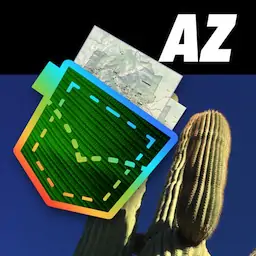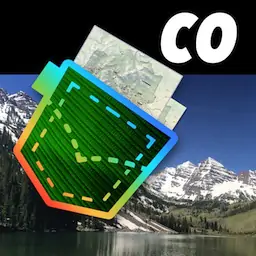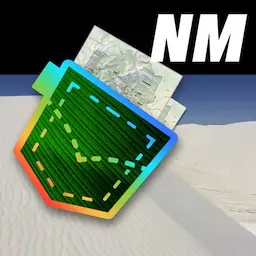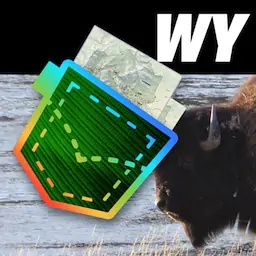WyomingNHT Auto Tour Guides |
The National Historic Trail route across Wyoming. Published by the National Park Service (NPS).
featured in
covered parks
National Trails System
National Park Service
U.S. Department of the Interior
National Historic Trails
Auto Tour Route Interpretive Guide
Across Wyoming
“Rendezvous,” by
William Henry Jackson
NATIONAL HISTORIC TRAILS
AUTO TOUR ROUTE INTERPRETIVE
GUIDE
Across Wyoming
Prepared by
National Park Service
National Trails Intermountain Region
www.nps.gov/cali
www.nps.gov/oreg
www.nps.gov/mopi
www.nps.gov/poex
NATIONAL PARK SERVICE
US DEPARTMENT OF THE INTERIOR
Third Printing December 2016
Historical marker on South Pass recognizing the first “white” women to make
the trek to Oregon in 1836.
CONTENTS
Introduction . . . . . . . . . . . . . . . . . . . . . . . . . . . . . . . . . . . . . . 1
Gateway to the West . . . . . . . . . . . . . . . . . . . . . . . . . . . . . . . 2
Blazing the Trail . . . . . . . . . . . . . . . . . . . . . . . . . . . . . . . . . . . 5
Approaching the Rockies. . . . . . . . . . . . . . . . . . . . . . . . . . . . 7
Sweetwater to South Pass . . . . . . . . . . . . . . . . . . . . . . . . . . 13
Beyond the Great Divide . . . . . . . . . . . . . . . . . . . . . . . . . . . 18
Leapfrogging Across Wyoming . . . . . . . . . . . . . . . . . . . . . . 23
Ho for California! Oregon or Bust! . . . . . . . . . . . . . . . . . . . 27
Fire on the Plains . . . . . . . . . . . . . . . . . . . . . . . . . . . . . . . . . 30
God Speed to the Boy & the Pony! . . . . . . . . . . . . . . . . . . . 34
The End of the Trail Era . . . . . . . . . . . . . . . . . . . . . . . . . . . . 36
Sites and Points of Interest. . . . . . . . . . . . . . . . . . . . . . . . . .37
Auto Tour Segment A —Nebraska State Line to Casper . . . . . . .
Auto Tour Segment B —Casper to Seedskadee . . . . . . . . . . . . . .
Auto Tour Segment C —The Lander Road. . . . . . . . . . . . . . . . .
Auto Tour Segment D —Seedskadee to Idaho State Line. . . . . . .
Auto Tour Segment E —Seedskadee to Utah State Line. . . . . . . .
38
50
68
70
71
For More Information/Credits . . . . . . . . . . . . . . . . . . . . . . . 74
Regional Map. . . . . . . . . . . . . . . . . . . . . . . . Inside Back Cover
Eastern view of the Sweetwater River Valley from atop Independence Rock, by
William Henry Jackson. Image is courtesy of the Brigham Young University Online
Collection.
Auto Tour Route Interpretive Guide
Wyoming
INTRODUCTION
Auto Tour
Route
any of the pioneer trails and other
M
historic routes that are important in
our nation’s past have been designated by
Congress as national historic trails. While
most of those old roads and routes are not
open to motorized traffic, people can drive
along modern highways that lie close to
the original trails. Those modern roads are designated as Auto Tour
Routes, and are marked with highway signs and trail logos to help
today’s travelers follow the trails used by the pioneers who helped to
open a new nation.
This interpretive publication guides visitors along the Auto Tour
Routes for the Oregon, California, Mormon Pioneer, and Pony
Express national historic trails as they as they cross the state of
Wyoming from east to west. Site-by-site driving directions are
included, and an overview map is located inside the back cover. To
make the tour more meaningful, this guide also provides a historical
overview of the four trails, shares the thoughts and experiences of
emigrants who followed those routes, and describes how westward
expansion impacted native peoples of the Intermountain West.
National Park Service interpretive brochures for the Oregon,
California, Mormon Pioneer, and Pony Express national historic trails
are available at many trail-related venues, or can be requested via
email to ntir_information@nps.gov. Additional information on each
trail also can be found on individual trail websites. Links are listed on
the title page of this guide.
Auto Tour Route Interpretive Guide
Wyoming
GATEWAY TO THE WEST
History is geography set into motion.
—Johann Gottfried Herder, 18th century philosopher of history
T
he Rocky Mountains stretch like a jagged spine between Alaska
and Mexico, splitting North America into East and West. The
Continental Divide is not a simple line of peaks, easily threaded by
tracks and roads, but a complex of overlapping mountain ranges and
treeless sagebrush steppe, hundreds of miles wide. In the days of
covered wagon travel, the Rockies were an imposing barrier to the
movement of people, commerce, and communications.
Early explorers probed the Northern Rockies looking for the
fabled “Northwest Passage” that would open an easy route for
transcontinental traffic. The men of Lewis and Clark’s Corps of
Discovery finally put that myth to rest in 1805, when they nearly
perished crossing Montana’s Bitterroot Range at Lemhi Pass. But
the Absarokas (Crows), Shoshones, and other tribes knew of a much
easier gateway through the mountains some 400 miles farther south,
in today’s Wyoming.
A small band of traders from the Pacific Fur Company discovered
their secret in 1812. Robert Stuart and his men left Fort Astoria, a
company post on the Columbia River, in June of that year to carry
business dispatches overland to New York. Misfortune nipped
their heels from the start: one man attempted suicide, mosquitoes
were a constant torment, and a Shoshone guide ran off with Stuart’s
horse. But before disappearing, the guide told the Astorians of a
shorter route through the central Rockies, and they decided to look
for it on their own. Three months into their journey, snarling fate
turned vicious: as the traders approached the Teton Range near
today’s Idaho-Wyoming border, an Absaroka war party captured all
their horses. Now Stuart’s men were afoot in unfamiliar country, a
thousand miles from any settlement, without supplies and on the
sharp edge of a Rocky Mountain winter. The desperate men were
picking their way eastward when they struck an Indian trace that led
them south of the Wind River Range and through a broad pass over
the Great Divide. They had found the Shoshone’s “shorter route,” but
still were deep in unfriendly wilderness. After a hungry winter spent
2
Auto Tour Route Interpretive Guide
Wyoming
huddled on the eastern plains of Wyoming, Stuart’s tough little band
finally reached St. Louis in April 1813, bringing news of the southern
pass that could open the continent to wagon travel.
Their news was drowned out by the commotion of conflict with
England, the War of 1812. The great southern pass was forgotten until
friendly Absarokas directed a small party of mountain men, which
included the legendary Jedediah Smith, James Clyman, and Thomas
Fitzpatrick, through the gap in 1824.
Then, at last, geography “set into motion.” Trappers and pack-mule
caravans began carrying supplies over South Pass to the annual fur
trade fair, or Rendezvous. Mountain man William Sublette took
the first wagons to Rendezvous in 1830, but stopped just east of the
Continental Divide. Although Sublette showed that loaded wagons
could make the trip into the mountains, the “fur trace” was so rough
that he returned with pack mules the next year. Captain Benjamin L.
E. Bonneville, leading a 20-wagon supply train, blazed the first wagon
“Emigrants Crossing the Rocky Mountains.” Image is courtesy of the Library of Congress.
3
Auto Tour Route Interpretive Guide
Wyoming
track over South Pass in 1832, and more carts and wagons followed.
Soon other travelers began joining up with the annual fur caravans
for safe overland passage. Missionaries Marcus & Narcissa Whitman
and Henry & Eliza Spalding crossed the Rockies with the fur brigade
in 1836, proving that women were not too delicate for the trials of
the trail. Four years later, emigrants Joel and Mary Walker, with four
children and two covered wagons, joined the last supply caravan
heading to the very last trappers’ Rendezvous. They reached Oregon
in September 1840, and in January Mary gave birth to a daughter. The
Walkers showed that even children and mothers “in a family way”
could make the 2,000-mile overland trip. Their example helped open
the floodgates of the emigration.
First a trickle, then a stream, and finally a torrent of humanity,
livestock, and technology poured through South Pass over the next
three decades. Government survey parties and soldiers, missionaries,
emigrant wagon and handcart companies, hopeful gold-seekers
and adventurers, countless stage and mail coaches, commercial
freight wagons, riders of the Pony Express, and the transcontinental
telegraph — all funneled through that 20-mile-wide passage over the
Continental Divide. So many hooves and wheels cut into the earth
that the ground in places is still scored with ruts.
South Pass was the gateway to the West. Without that accident of
geography, there would have been no Oregon Trail, no California
Trail, no Mormon Utah, and perhaps no United States stretching
from the Atlantic to the Pacific.
And it comes forcibly to
mind that this passage in the
great Rocky Mountains was
fashioned by the supreme
ruler to aid the progress of
the American people in their
westward march to the Pacific
Ocean. —Joseph Buffum,
1849 California emigration
South Pass - Gateway to the West.
4
Auto Tour Route Interpretive Guide
Wyoming
BLAZING THE TRAIL
T
he first emigrant wagon train bound for California, known as
the Bidwell-Bartleson Party, struck out from Independence,
Missouri, in the spring of 1841. “Our ignorance of the route was
complete,” admitted John Bidwell, a 21-year-old Pennsylvania
schoolteacher who lent his name and leadership to the wagon
company. “We knew that California lay west, and that was the extent of
our knowledge.”
That was the extent of most everybody’s knowledge. The trail in
1841 was barely a track worn along the Platte River by the packmule and cart caravans of the Rocky Mountain fur trade. Hopeful
greenhorns would have no beaten wagon road to follow over plain
and mountain to California or Oregon. No useful map of the route
existed. Emigrants would find no road signs, no bridges or ferries
at river crossings, and no place to replace exhausted oxen and food
supplies. The 68 souls who first set out with John Bidwell into that
arid unknown have been praised as bold visionaries and spurned as
risk-taking fools.
“Pilgrims of the Plains,” by Alfred R. Waud, Harpers Weekly, December 23, 1871.
Illustration is courtesy of the Library of Congress.
5
Auto Tour Route Interpretive Guide
Wyoming
Whatever they were, they were also lucky. A few days out of
Independence they managed to join up with Thomas “Broken Hand”
Fitzpatrick, who was already guiding a company of missionaries to
the Pacific Northwest. The famous mountain man agreed to take the
emigrants along the Platte and through the Rockies as far as the Fort
Hall area in today’s Idaho. From there they would have to find their
own way. Amazingly, they did.
The way Fitzpatrick took his pilgrims—on the old trappers’ route
up the North Platte River into central Wyoming, up the Sweetwater,
and over South Pass— became the corridor of the combined Oregon,
California, Mormon Pioneer, and Pony Express Trails. Government
maps of the route published in 1843 and 1845 gave others the
confidence to set out for the West. Within a few years, a rising stream
of emigrant wagons had beat the old “fur trace” into a road that the
greenest tenderfoot could follow.
To all of my acquaintances
and friends who may
be in bad health I would
recommend a trip to
California. —John Bidwell,
1841 California emigration
6
Auto Tour Route Interpretive Guide
Wyoming
APPROACHING THE ROCKIES
M
ost emigrants agreed that the easiest part of the overland trail
was the 500-mile stretch that followed the Platte River across
Nebraska’s prairie. The country grew rougher and the scenery more
wonderful as the wagons rumbled up either side of the Platte’s north
fork, past Chimney Rock and Scotts Bluff, and into Wyoming. In the
vicinity of today’s town of Lingle, the trail crossed an undistinguished
grassy flat where an 1854 shootout between Sioux and soldiers—
the Grattan Fight—would unleash the bloody Plains Wars. A
shallow mass grave and grisly artifacts marked the battle site for the
continuing emigration.
By the time travelers reached that sober milestone, they had been
six to eight weeks on the trail. Their enthusiasm for wayside points
of interest was dampened by the weary rhythm of the road: rise
before dawn, cook, clean up, repack, gather and yoke the oxen…
and then plod through the dust all day to set up another camp about
12-15 miles up the road. Fort Laramie, 50 miles west of Scotts Bluff,
Nebraska, provided a welcome break from the tedium.
“Old Fort John,” renamed later as Fort Laramie, by William Henry Jackson.
Image is courtesy of Scotts Bluff Nat’l. Monument.
7
Auto Tour Route Interpretive Guide
Wyoming
In 1841, when the Bidwell-Bartleson Party stopped in for a twoday layover, the fort (then called Fort John) was a simple adobe
trading post bustling with fur traders, trappers, Plains Indians,
and adventurers. Eight years later, the U.S. Army purchased the
establishment for a military post to protect and help re-supply the
ever-increasing overland traffic. Fort Laramie soon grew into a busy
community of soldiers, army wives, laundresses, children, servants,
and quartermaster employees. Teepee encampments settled in
around the fort, which became a multi-ethnic “travel plaza” on the
overland highway. There, emigrants could post their mail, repair
wagons, shoe livestock, and shop for necessities (and liquor) at the
post sutler’s store. They also could visit and trade with the fort’s
Indian residents — a thrill that many emigrants recorded in their trail
journals.
Many of these [Sioux] women,
for regularity of features and
symmetry of figure, would
bear off the palm of beauty
from some of our most
celebrated belles…. The men
are powerfully made, and
possess a masculine beauty
which I have never seen
excelled. —Edwin Bryant,
1846 California emigration
8
I remember with what terror
I saw the Indians come out
from Fort Laramie. They
looked so naked and wild.
The men got out their guns but
all the Indians wanted was
to see us to see if we would
give them anything. —Lucy
Ann Henderson Deady on
crossing the trail at age 11,
1846 Oregon emigration
We were visited…by about
two hundred Cheyennes and
Sioux, who danced a little,
stole a little, eat a great deal,
and finally went on their
way rejoicing. —“Nebraska,”
anonymous newspaper
correspondent at Fort
Laramie, 1849
Auto Tour Route Interpretive Guide
Wyoming
Most travelers approached Fort Laramie from the main Oregon and
California roads along the south bank of the North Platte River. This
required fording a tributary, the Laramie River, just east of the fort.
Today, dams have tamed the Laramie, but in the mid-1800s the river’s
spring current sometimes toppled wagons and drowned emigrants
and livestock. Looking for the safest places to ford, travelers used at
least nine different crossings of the Laramie, and bridges and ferries
eventually served some locations.
In the early years of the emigration, the terrain on the north side
of the river was thought to be impassable west of Fort Laramie.
Mormon emigrants and others entering Wyoming on the north-bank
road were forced to ford the deep, swift North Platte near the fort.
Starting in 1850, north-side emigrants had the option of loading their
wagons onto a ramshackle flatboat and pulling the contraption along
a rope stretched across the river — unassisted, and at the outrageous
fare of $1 per wagon. The price of passage drove some offended
emigrants to blaze a new trail, Child’s Cutoff (also called Chiles’s
Route), which continued west on the north side of the river. Travelers
who stayed on the north bank via Child’s Cutoff could avoid crossing
the North Platte altogether, while those following the original southbank road had to cross upstream, near today’s city of Casper. By
1852, most wagons arriving on the north side continued up Child’s
Cutoff, though many travelers still crossed the river to visit Fort
Laramie. A graceful iron military bridge, built in 1875, still spans one
of four emigrant crossings of the North Platte near the fort. Sparkling
placidly beneath the bridge, the river strikes today’s summertime
visitor as a mere pleasant wade, unlike the fearsome mountain torrent
of 150 years ago.
For travelers north or south of the river, Fort Laramie was a major
milestone, sitting at the edge of the western plains where the land
begins to lift toward the slopes of the Rockies. West of the fort rose
the blue-gray beacon of Laramie Peak, looking “like a dark cloud
on the western horizon,” according to John Bidwell. The steepest,
roughest, driest, and most dangerous stretches of road lay ahead.
Travelers paused to lighten their wagons by selling unnecessary
items—tools, books, clothing, furnishings, even wagons and food—
at Fort Laramie, but buyers were scarce. Most disappointed sellers
simply destroyed or dumped their possessions along the trail
9
Auto Tour Route Interpretive Guide
Wyoming
and moved on. Forty-niner J. Goldsborough Bruff saw “bacon in
great piles, many chords [cords] of it” and a “diving bell and all the
apparatus” among the items abandoned in the Wyoming dust.
On the road from the fort.... I
saw a wagon—tolerable good
but heavy—bacon, beans,
stoves, chairs, iron wedges,
crow bar, soap, lead, ovens
and many other articles all
laying about in the prairie.
They could not use them and
they could not carry them,
and the only alternative
was to leave them. —Israel
F. Hale, 1849 California
emigration
Merchandise that in the States
has cost thousands upon
thousands is thus disposed of
by sufferers whose life is still
of the most value. —Edward
C. Harrow, 1849 California
emigration
Wagons are worth nothing.
We frequently cook our
suppers with the spokes of a
better wagon than half the
farmers in St. Louis county
own. —“R.H.D.,” newspaper
correspondent, 10 miles west
of Fort Laramie, 1859
Ten miles northwest of the army post, travelers on the south side of
the river reached their next campsite, called Sand Point, near today’s
Guernsey, Wyoming. (In 1860-61, the Centre Star Pony Express
station was located there, too.) Some paused between endless camp
chores to carve their names into the soft stone face of Register Cliff.
Pioneer emigrant
signatures etched in the soft
sandstone of Register Cliff.
10
Auto Tour Route Interpretive Guide
Wyoming
A few miles beyond, the wagons fell into single file for a hard pull
up a rock ridge, avoiding boggy ground nearer the river. Thousands
of iron-shod hooves and wagon wheels gradually cut a verticalwalled channel deep into the stone there, at a site now known as the
Guernsey Ruts, or Deep Hill Ruts.
The trails followed the arc of the North Platte River deep into central
Wyoming. Once wagons started taking Child’s Cutoff, profit-minded
men established toll bridges and ferries at several locations between
Fort Laramie and today’s city of Casper. These allowed wagons
to zigzag back and forth across the river to avoid sand hills and
other difficult spots. At Casper the river curved southwest across
the emigrant route, forcing those on the south side to make a final
crossing there or a few miles farther west near Red Buttes (now called
Bessemer Bend).
And that was the end of the Platte River lifeline that had conducted
the emigration across hundreds of miles of prairie and plain. Now the
need for water and grass would become a nagging worry.
A short distance beyond the last crossing of the North Platte at Red
Buttes, all the trails came together for the hot, hard haul over Devil’s
Backbone (also called Avenue of Rocks) to the next good water at
It is considered by all to be
the worst camping ground
we had had on the journey.
Its banks are so perfectly soft
that a horse or ox cannot get
down to drink without sinking
immediately nearly overhead
in thick, filthy mud, and [it]
is one of the most horrid,
swampy, stinking places I
ever saw. —William Clayton
on Clayton’s Slough, 1847
Mormon emigration
. . . but oh my poor pony . . .
no grass no grass . . . but he
is a fine fellow & deserves a
better fate than to starve.
—Charles B. Darwin
at Willow Spring, 1849
California emigration
11
Auto Tour Route Interpretive Guide
Wyoming
Willow Spring. Along this stretch, travelers on all the trail variants and
cutoffs of the Oregon, California, and Mormon Pioneer trails merged
for the first time onto the same road. Now their teams faced a long
pull up Prospect Hill, where wagon wheels wore multiple ruts and
swales that still are visible. Two miles farther was the next watering
hole for the thirsty oxen: an odorous alkali marsh called Clayton’s
Slough, jokingly named after an 1847 Mormon pioneer who had
nothing good to say about the place. Hardworking oxen (and people)
that drank too deeply of alkaline water often died of digestive upsets
and dehydration. Good water was available about four miles farther
west at Horse Creek, where a Pony Express station stood in the 1860s.
From there the road stretched another 10 dry miles to the Sweetwater
River. Grass was scarce all along the route.
This leg of the trip, Emigrant Gap (today sometimes called the Poison
Spider Route), was a bitter introduction to what lay ahead: long
stretches of hot, hilly trail with little feed for the animals, punctuated
with stinking, toxic alkali waterholes. That poisonous 30-mile stretch
between the North Platte and lovely Sweetwater Valley would kill
many an ox and emigrant through the overland trail years.
All the air is strongly
impregnated with effluvia
from dead oxen it is like
walking over a field of battle
after three hot suns have
[beat] upon the thousand
dead. —Charles B. Darwin
on the Emigrant Gap
segment, 1849 California
emigration
12
Here [at Poison Slough,
west of Willow Spring] are
the graves of some five or
six persons who drank of
the water and died in a few
minutes. Notices are stuck
over the graves and at the
road side… “He drank of this
water and died.” “Drank at
this spring and died.” “This
water is poison.” “Death!”
“Poison!” “Beware! For
God’s sake do not taste this
water! Happy is the man who
can read!” —James W. Evans,
1850 emigration
Auto Tour Route Interpretive Guide
Wyoming
SWEETWATER TO SOUTH PASS
T
he great granite loaf of Independence Rock signaled temporary
relief from the thirsty barrens, for it stands where the emigrant
trail meets the Sweetwater River. Trail tradition held that reaching
this milestone by the Fourth of July meant the emigrants would arrive
safely in Oregon or California before early blizzards blew. People
often paused here to rest their livestock and explore the formation,
probably the most famous landmark on the combined Oregon,
California, Mormon Pioneer, and Pony Express routes. Many
travelers chiseled or painted their names on the outcrop, turning
Independence Rock into a permanent memorial to the passing
emigration.
Came to independence rock
about ten o clock this morning
I presume there are a million
of names wrote on this rock
—Lydia Allen Rudd, 1852
Oregon emigration
Names! Names! Are every
where upon its surface to be
seen. names of the young
& the old, of the man & his
gentle mate, of the learned
traveler & the yellow ideaed
gold hunter. —Charles B.
Darwin, 1849 California
emigration
“Independence Rock,” by William Henry Jackson.
Image is courtesy of Scotts Bluff Nat’l. Monument.
13
Auto Tour Route Interpretive Guide
Wyoming
Independence Rock also marked the beginning of South Pass, for
the pass was not just the single point where the trail crested the
Continental Divide. It was, in the minds of emigrants, the entire 100mile climb up the Sweetwater to the divide. Emigrants and oxen on
this uphill stretch would have good water—and lots of it, as they would
cross the cold, meandering Sweetwater nine times. Even here, though,
in peak emigration years, grass was scarce and livestock went hungry.
People, as well, suffered along this stretch of trail. In the Sweetwater
Valley, many travelers began taking sick with a mysterious, aching
ailment they called “mountain fever.” They blamed their illness on
mosquitoes, altitude, and the alkali dust, but doctors today think it
was a tick-borne disease such as Rocky Mountain Spotted Fever.
And as they climbed toward the mountain pass, emigrants regretted
having abandoned warm bedding and clothing along the trail. High
elevations can bring chilly summertime winds, freezing nighttime
temperatures, and the threat of snowstorm in July. In fact, weather
in this mountain country has been known to deliver disaster to the
unprepared. In 1856, an October blizzard trapped four late-departing
Mormon handcart and wagon companies, with nearly 1,400 men,
women, and children among them, in the Sweetwater Valley. Despite
the heroic efforts of rescuers from Salt Lake City, many of the
Sweetwater Valley near Devil’s Gate, Wyoming.
14
Auto Tour Route Interpretive Guide
Wyoming
emigrants —historians’ counts range from about 170 to over 300 —
did not survive the ordeal.
Mountain-rimmed Sweetwater Valley can be cold and merciless, but
it is also a place of sublime natural beauty. Despite the hazards they
faced there, some awestruck 19th century emigrants paused to write
poetically of this segment of trail.
The Sweet Water flows
through the flat below us
in many a graceful curve,
looking like a huge serpentine
silver thread in the rich
emerald green. Before us,
behind us, all around us,
are mountains piled on
mountains…. —Nellie
Phelps, 1859 California
emigration
I had many pleasing
reflections while traveling
alone in this sequestered
and remote part of the earth
where the footprints of a
white man is seldom seen and
all nature appears as though
nothing had been molested
since it rolled out of the Hands
of the Creator. —Henry Lunt,
1857 Utah emigration
As they trekked up the Sweetwater Valley, travelers passed several
notable trail milestones. First was Devil’s Gate, a natural curiosity
that puzzled many an emigrant: what caused the Sweetwater River to
chew a channel through the ridge instead of flowing around it? Then
came Split Rock, a “gun-sight” notch in the Rattlesnake Range that
aimed travelers directly toward South Pass, some 75 miles distant. At
Ice Slough, astonished emigrants dug clear, sweet ice—a treat!—from
beneath the turf in mid-summer. Barren, wind-slapped Rocky Ridge,
a 700-foot climb through broken rock, was always an ordeal for
wagons and teams, and particularly so for Mormon emigrants pulling
loaded handcarts. Finally, the trail threaded between Twin Mounds,
two low hills that marked the final approach to the Continental
Divide. Through the years of the emigration, this Sweetwater-toSouth Pass stretch also became dotted with trading posts, Indian and
army encampments, and Pony Express, stage, and telegraph stations.
15
Auto Tour Route Interpretive Guide
Wyoming
Devil’s Gate on the Sweetwater River, Wyoming.
To the northwest bared the ferocious, snow-covered sawteeth of the
Wind River Range, which fretted many an emigrant. It was needless
worry, as the trail passed south of the Wind Rivers, not through them.
The grade up and over South Pass, about 7,550 feet in elevation, is so
gradual and mild that most travelers never knew exactly when they
crossed the Continental Divide. In his journal entry of July 18, 1841,
John Bidwell noted casually, “Crossed the divide which separates the
water of the Atlantic and Pacific oceans.”
The long-anticipated crossing of the Great Divide was a letdown! But
travelers to Oregon and California were still less than halfway through
their journey. More serious challenges lay ahead.
There we saw the far famed south pass, but did not see it until we
had passed it for I was all the time looking for some narrow place
that would almost take your breath away to get through but was
disappointed. —Amelia Hadley, 1851 Oregon emigration
16
Auto Tour Route Interpretive Guide
Wyoming
What is called the Pass in
the Rocky Mountains is not
as most persons suppose, a
narrow passway through
frightful over-hanging
mountains with wild streams
dashing down their acclivities,
but on the contrary it is a
scarcely perceptible ascent,
and when the summit is
reached the traveller is not
aware of it and frequently
asks where is the Pass?
—William A. Carter, sutler at
Fort Bridger, 1857
Came to the Ice Springs,
which certainly are
remarkable…in cutting
through a wet grassy
strip, we came to solid
ice, which was eagerly
gathered and eaten by our
delighted and astonished
selves. Some Doubted its
being ice,—but it looked
like ice, smelt like ice,
tasted like ice, felt like ice,
and—I believe it was ice.
—Nellie Phelps, 1859
California emigration
South Pass still looks much as it did during covered wagon days.
17
Auto Tour Route Interpretive Guide
Wyoming
BEYOND THE GREAT DIVIDE
A
fter sharing a common broad corridor through Nebraska and
Wyoming, overland traffic burst up and over the Continental
Divide like spray from a hose. Three main trunk routes, linked by a
snarl of alternative cutoffs, fanned out across western Wyoming: the
Lander Road, the Sublette Cutoff, and the Fort Bridger route.
The Lander Road, one of a small handful of Western emigrant roads
ordered and funded by Congress, was the last of the three routes to
be opened. Frederick W. Lander, a government engineer with the
Department of the Interior, surveyed and built the road in 1857-59 to
improve transportation to the western states. Lander saw that many
travel problems, including the suffering of the oxen, arose from “the
extreme dryness and heat of the artemisian [sagebrush] deserts,” so he
routed his cutoff on the northern side of South Pass through cooler,
higher areas with more grass and water. The Lander Road forked off
the main trail at the ninth crossing of the Sweetwater, just east of the
Continental Divide, and angled northwest. It crested the divide north
of today’s Highway 28, entered Idaho west of Auburn, Wyoming,
and rejoined the main Oregon and California road near Fort Hall,
Idaho. This northerly route stayed well clear of Utah, where troubles
were then brewing between the federal government and the Mormon
followers of Brigham Young. For awhile, though, the Lander Road
was a preferred stalking ground of “white Indians” —white men
disguised as Indians— who lured emigrant families away from the
main road and cruelly murdered them for their belongings. White
criminals were responsible for several particularly brutal incidents on
the Lander after it opened in 1859.
You have no idea of the confusion and uncertainty in the
minds of the emigrants as to which was the best route to
take….Some said you had to buy the land in California while
in Oregon it was free….Some advised us to take the short cut
across the 45-mile desert, avoiding going to Fort Bridger.
—Lucy Ann Henderson Deady on crossing the trail at age
11, 1846 Oregon emigration
18
Auto Tour Route Interpretive Guide
Wyoming
The main trail on the southern side of South Pass headed toward the
bright green marsh of Pacific Springs, just west of the Continental
Divide. Cattle would mire themselves at this swampy campsite if their
owners did not take care, but Pacific Springs provided the last good
water and abundant feed they would find for a couple of days. From
here travelers entered a grassless, gray-green ocean of sagebrush,
starvation country for the weary oxen. Next water was about 10 miles
ahead at Dry Sandy Crossing, a miserable spot where alkali pools
fatally poisoned seve













